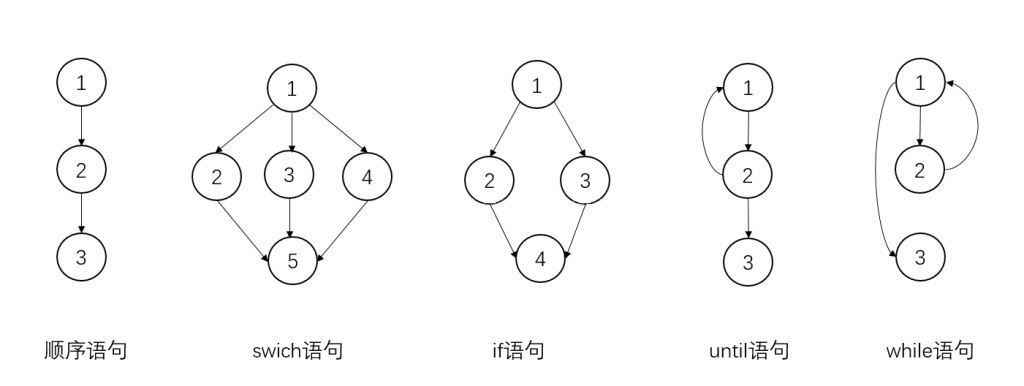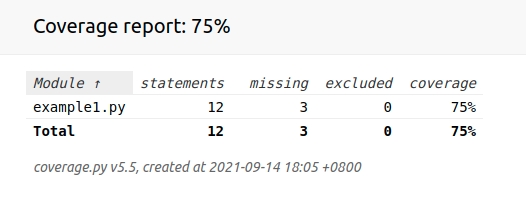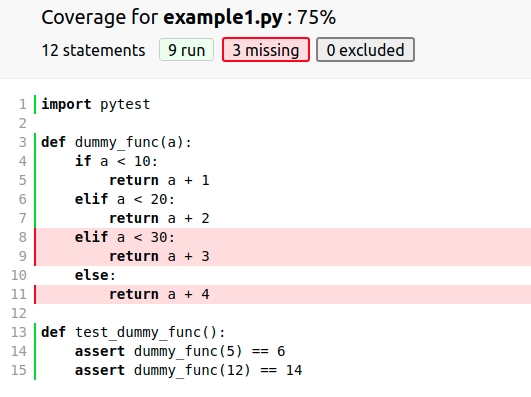单元测试贡献指南(建设中)
1. 什么是单元测试
单元测试是针对程序的最小单元来进行正确性检验的测试工作。程序单元是应用的最小可测试部件。一个单元可能是单个程序、类、对象、方法等。 ——维基百科
2. 为什么要写单元测试
2.1 大家不愿意写单元测试的常见原因
功能很简单,没必要测,不写了
开发时间紧,没时间写,不写了
测试代码多,不好维护,不写了
用例难构造,不太会写,不写了
跳出舒适区,一份高质量的代码从写单元测试开始。
2.2 单元测试的重要性
**帮助理解需求:**单元测试应该反映 Use Case,把被测单元当成黑盒测试其外部行为
**提高实现质量:**单元测试不保证程序做正确的事,但能帮助保证程序正确地做事,从而提高实现质量
**反馈速度快:**单元测试提供快速反馈,把 Bug 消灭在开发阶段
**利于重构:**由于有单元测试作为回归测试用例,有助于预防在重构过程中引入 Bug
**文档作用:**单元测试提供了被测单元的使用场景,起到了使用文档的作用
**对设计的反馈:**一个模块很难进行单元测试通常是不良设计的信号,单元测试可以反过来指导设计出高内聚、低耦合的模块
2.3 举例
3. 单元测试测什么
3.1 输入测试
3.1.1 参数类型测试
输入是否为期望的类型,例如是否为整型或者列表中的元素是否为整型
3.1.2 非法参数测试
测试输入是否合法,例如要求除数不能为 0
3.1.3 边界测试
测试输入是否符合上下界
3.1.4 全局变量测试
测试全局变量的值是否正确
3.1.5 生成器测试
测试生成器的返回值是否符合期望
3.2 输出测试
测试输出是否符合预期
3.3 控制流测试
参考 https://testerhome.com/topics/19991
控制流测试是一种在考虑测试对象的控制流情况下导出测试用例的测试方法,并且借助于控制流图(Control Flow Graph)能评估测试的完整性(覆盖率)。
3.3.1 控制流图
控制流图(Control Flow Graph,CFG)也叫控制流程图,是一个过程或程序的抽象表现,是用在编译器中的一个抽象数据结构,由编译器在内部维护,代表了一个程序执行过程中会遍历到的所有路径。 它用图的形式表示一个过程内所有基本块执行的可能流向, 也能反映一个过程的实时执行过程。
控制流图是一个带有开始节点和结束节点的有向图
程序的指令(语句)是通过节点来表示的
一个不带分支和汇总的语句序列可以简单地用一个节点来表示
语句之间的路径通过有向线(控制流)表示
控制流图的开始和结束节点在实际应用中常常被省略
下图是控制流图的几种结构,大多数程序可以由以下几种结构组合而成。

3.3.2 主要测试方法
围绕下面的例子介绍控制流测试的主要测试方法
3.3.3 语句覆盖
在控制流中每条可执行的语句至少被执行一次。
必要的、最简单的,但也是最弱的标准
无法检测到缺失的语句
但能发现无法执行到的语句(死代码)
语句覆盖率 = 已执行的语句数目 / 所有语句的总数目 * 100%构造测试用例
A = True, B = True, C = True, D = True
上述的测试用例可使语句覆盖率 100 %
3.3.4 分支覆盖(判定覆盖)
在控制流图内的每一条边都至少被执行一次。
在实践中作为最小的测试标准
能发现无法执行到的程序分支
无法发现缺失的分支
没有测试到分支的组合
分支覆盖率 = 已执行的分支数目 / 分支总数目 * 100%构造测试用例
A = True, B = True, C = True, D = False
A = True, B = False, C = False, D = False
上述的测试用例可使分支覆盖率 100 %
3.3.5 条件覆盖
每一个条件的可能取值都应该被测试到。
每一个条件的可能取值都覆盖到
未必能覆盖所有分支
条件覆盖率 = 已执行的判定结果 / 所有的判定结果总数 * 100%构造测试用例(即 A, B, C, D 的值至少都取过 True 和 False)
A = True, B = True, C = True, D = True
A = False, B = False, C = False, D = False
上述的测试用例可使条件覆盖率 100 %
3.3.6 路径覆盖
在控制流图内的每一个分支序列(路径)都应该执行一次。
在包含循环时,可能会有无数的路径
在具有 k 个连续的分支时,则会有 2**k 种不同的路径
构造测试用例(每个分支的值至少取过 True 和 False)
A = True, B = True, C = True, D = True
A = False, B = False, C = False, D = False
A = True, B = True, C = False, D = False
A = False, B = False, C = True, D = True
上述的测试用例可使路径覆盖率 100 %
4. 单元测试框架介绍
本节代码示例地址:https://github.com/zhouzaida/unittest-tutorial
4.1 pytest
pytest 是一个测试框架,简化编写易读以及可扩展的测试流程。测试代码和代码一样,也要求是可读的。使用 pytest 构建测试非常简单,我们可以在几分钟内就可以为应用程序或库进行小型单元测试或复杂的功能测试。
4.1.1 安装
4.1.2 入门用法
编写函数的单元测试
使用下面的命令即可启动测试
编写类的单元测试
4.1.3 进阶用法
fixture 为单元测试提供了预定义的、可信赖的以及上下文一致的测试环境。fixture 可以包含一些环境的设置,例如连接数据库或者关闭数据库,也可以包含一些多个单元测试共享的测试数据。
共享测试数据
两个测试用例使用同一个测试数据
预定义的临时目录 tmp_path
Pytest 提供了很多内置的 fixture,可以简化测试用例的重复代码。tmp_path 是其中的一个 fixture(更多 fixture 见 Pytest API and builtin fixtures),为测试用例提供唯一的临时目录,测试完成后该临时目录会被自动清理。
不使用 tmp_path
使用 tmp_path
mmcv 的使用场景
mark
parametrize使用 pytest.mark.parametrize 去除冗余的代码
跳过测试用例
无条件跳过测试用例
如果想在运行时才判断是否跳过,则可以使用 pytest.skip
有条件跳过测试用例
下面是 MMCV 中的一个例子,有些算子的实现只有 GPU 版本,如果在只有 CPU 的环境,那么测试 GPU 版本的算子会报错,所以需要跳过没有 CPU 实现的算子
使用断言判断代码是否抛出期望的异常
4.2 unittest
unittest 模块提供了一系列创建和运行测试的工具。
4.2.1 基本用法
这是一段简短的代码,来测试三种字符串方法:
继承 unittest.TestCase 就创建了一个测试样例。上述三个独立的测试是三个类的方法,这些方法的命名都以 test 开头。 这个命名约定告诉测试运行者类的哪些方法表示测试。每个测试的关键是:调用 assertEqual() 来检查预期的输出; 调用 assertTrue() 或 assertFalse() 来验证一个条件;调用 assertRaises() 来验证抛出了一个特定的异常。使用这些方法而不是 assert 语句是为了让测试运行者能聚合所有的测试结果并产生结果报告。通过 setUp() 和 tearDown() 方法,可以设置测试开始前与完成后需要执行的指令。 在 组织你的测试代码 中,对此有更为详细的描述。最后的代码块中,演示了运行测试的一个简单的方法。 unittest.main() 提供了一个测试脚本的命令行接口。当在命令行运行该测试脚本时
上文的脚本生成如以下格式的输出:
在调用测试脚本时添加 -v 参数使 unittest.main() 显示更为详细的信息,生成如以下形式的输出:
以上例子演示了 unittest 中最常用的、足够满足许多日常测试需求的特性。当然我们也可以使用以下的命令运行测试
4.2.2 组织测试结构
https://asciinema.org/a/435174
setUp()和tearDown() 在单个测例被测试前后调用,前者在测试前,后者在测试后。setUpClass()和tearDownClass() 在整个测试类中只会被调用一次,前者在类被测试前调用,后者在类被测试后调用。
4.2.3 组织测试顺序
https://asciinema.org/a/435177
测试类中的测试方法被测试的默认顺序按照方法名根据字符序来调用的,但我们可以通过 TextSuite 来定制测试方法的测试顺序
默认顺序
定制顺序
需要使用python example4.py 启动测试,因为是在 __main__ 中重新组织了测试用例的调用顺序,而使用python -m unittest example ,该启动方式不会执行 __main__ 中的语句。
4.2.4 跳过测例
https://asciinema.org/a/435179
Unittest 支持跳过单个测试用例或者整个测试类
@unittest.skip(reason)
无条件跳过被装饰的用例
@unittest.skipIf(condition, reason)
如果 condition 为 True,则跳过被装饰的用例
@unittest.skipUnless(condition, reason)
如果 condition 为 False,则跳过被装饰的用例
@unittest.expectedFailure
被装饰的方法如果没通过测试或者报错,则认为是成功的一次测试
unittest.SkipTest(reason)
跳过测试用例
4.2.5 常用断言
a == b
a != b
bool(x) is True
bool(x) is False
a is b
a is not b
x is None
x is not None
a in b
a not in b
isinstance(a, b)
not isinstance(a, b)
4.3 mock
4.3.1 mock 是什么
模拟对象(mock object)是以可控的方式模拟真实对象(real object)行为的假对象。而之所以使用 模拟对象,是因为有时真实对象的行为是不确定的(例如真实对象是 http 请求)、真实对象很难搭建起来(例如 mmcv 需要在 github action 中测试 pavi,而 pavi 是 sensetime 内部库)、真实对象的行为很难触发(例如网络异常),这种情况下使用模拟对象可以隔绝依赖的影响,只关注代码的逻辑。unittest.mock 模块允许替换代码中的对象并且可以使用断言确认对象是否被调用。
4.3.2 基本用法
unittest.mock 中常用的两个核心类是 Mock、MagicMock 以及一个装饰器 patch,在这里只介绍 MagicMock、patch,因为MagicMock 是 Mock 的子类,MagicMock 默认提供了大多数魔术方法的实现,而 Mock 没有提供,如果 Mock 要使用魔术方法,需单独实现。注:Mock 和 MagicMock 的区别可参考以下两篇文章
MagicMock
A mock object
我们可以使用 mock 对象的 assert 方法检查对象的调用是否符合预期。
MagicMock 提供了很多断言方法,下面列出常用的几个方法,更多方法请浏览 the-mock-class
assert_called()
Assert that the mock was called at least once
assert_called_once()
Assert that the mock was called exactly once
assert_called_with(*args, **kwargs)
This method is a convenient way of asserting that the last call has been made in a particular way
assert_called_once_with(*args, **kwargs)
Assert that the mock was called exactly once and that call was with the specified arguments.
...
可以设置 mock 对象的返回值
side_effect 定义当 mock 对象被调用时将发生的行为。side_effect 的值可以是一个可回调对象,该函数在 mock 被调用时调用,也可以是一个可迭代对象,也可以是一个异常对象
side_effect 是可回调对象
side_effect 是可迭代对象
side_effect 是异常对象
An example
互动环节:分析test_get_package_verions()、test_get_package_versions_will_all_mock()、test_get_package_verions_with_mock()三种测试写法的优缺点
unittest.mock 提供了 patch 装饰器,可以将 mock 行为限制在测试用例的作用空间上。它既可以作为装饰器使用,也可以作为内容管理器。Magicmock 和 patch 的区别见 mocking-a-class-mock-or-patch
Decorator
Context Manager
事实上,在上面的例子中,我们并不需要 mock 整个对象,只需 mock get 方法即可
5. 测试覆盖率 coverage
coverage.py 是一个用来统计 Python 程序代码覆盖率的工具。
5.1 分析测试覆盖率
https://asciinema.org/a/435655
使用 coverage run 运行测试用例
使用 coverage report 生成测试报告
使用 coverage html 生成 html 页面,页面标记未被测试的行
生成 html 后打开index.html

点击example1.py可以查看未被测试的行

5.2 根据反馈完善单元测试
https://asciinema.org/a/435656
可以看到,通过添加更多的测试用例,example2.py 的行被完全覆盖了,即每一行都被测到了。
6. 运行 MMEngine 中的单元测试
6.1 命令行运行 mmengine 单元测试
命令行输入 pytest tests/test_hooks
得到如下
6.2 vscode debug 单元测试
安装配置 pytest 插件
根据以下步骤进行单元测试
选择 vscode 中“测试”图标、
点击
Configure Python Tests选择
pytest
接着可以看见下图,我们选择一个测试代码,这里以 tests/test_hooks/test_param_scheduler_hook.py 为例,选择类 TestParamSchedulerHook 中的方法 test_after_train_iter 。
在该方法左边有个运行按钮 “▶” ,点击该按钮进行单元测试。
测试完成后会显示完成图标✅
同样, pytest 支持 debug 断点测试,一共分为以下两步:
选择需要打断点
鼠标移至相关方法区域选择 debug 运行
运行后将中断于断点处
7. 参考资料
https://docs.python.org/zh-cn/3/library/unittest.html
https://docs.python.org/3/library/unittest.mock.html
https://docs.pytest.org/en/6.2.x/
最后更新于
这有帮助吗?